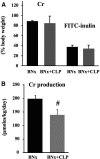Reduced production of creatinine limits its use as marker of kidney injury in sepsis - PubMed (original) (raw)
Reduced production of creatinine limits its use as marker of kidney injury in sepsis
Kent Doi et al. J Am Soc Nephrol. 2009 Jun.
Abstract
Although diagnosis and staging of acute kidney injury uses serum creatinine, acute changes in creatinine lag behind both renal injury and recovery. The risk for mortality increases when acute kidney injury accompanies sepsis; therefore, we sought to explore the limitations of serum creatinine in this setting. In mice, induction of sepsis by cecal ligation and puncture in bilaterally nephrectomized mice increased markers of nonrenal organ injury and serum TNF-alpha. Serum creatinine, however, was significantly lower in septic animals than in animals subjected to bilateral nephrectomy and sham cecal ligation and puncture. Under these conditions treatment with chloroquine decreased nonrenal organ injury markers but paradoxically increased serum creatinine. Sepsis dramatically decreased production of creatinine in nephrectomized mice, without changes in body weight, hematocrit, or extracellular fluid volume. In conclusion, sepsis reduces production of creatinine, which blunts the increase in serum creatinine after sepsis, potentially limiting the early detection of acute kidney injury. This may partially explain why small absolute increases in serum creatinine levels are associated with poor clinical outcomes. These data support the need for new biomarkers that provide better measures of renal injury, especially in patients with sepsis.
Figures
Figure 1.
BNx and subsequent sepsis induced by CLP. (A through E) Serum creatinine (A), AST (B), ALT (C), LDH (D), and serum TNF-α (E) were measured at 18 h after surgery (n = 5 to 6 per group). Data are means ± SEM. *P < 0.05 versus Sham BNx/Sham CLP; #P < 0.05 versus BNx.
Figure 2.
Effects of chloroquine treatment on BNx+CLP. (A through E) Serum creatinine (A), AST (B), ALT (C), LDH (D), and serum TNF-α (E) were measured at 18 h after surgery (n = 8 to 9 per each BNx group; n = 5 per sham group). Sham is Sham BNx/Sham CLP. Data are mean ± SEM. #P < 0.05 versus BNx+CLP.
Figure 3.
Volume of distribution (Vd) and estimated creatinine production. (A) Vd of creatinine and FITC-inulin were measured from 14 to 18 h after surgery. (B) Estimated creatinine production was measured at 0 to 14 h after surgery. Data are means ± SEM (n = 5 to 6 per group). #P < 0.05 versus BNx.
Similar articles
- Comparison of serum creatinine and serum cystatin C as biomarkers to detect sepsis-induced acute kidney injury and to predict mortality in CD-1 mice.
Leelahavanichkul A, Souza AC, Street JM, Hsu V, Tsuji T, Doi K, Li L, Hu X, Zhou H, Kumar P, Schnermann J, Star RA, Yuen PS. Leelahavanichkul A, et al. Am J Physiol Renal Physiol. 2014 Oct 15;307(8):F939-48. doi: 10.1152/ajprenal.00025.2013. Epub 2014 Aug 20. Am J Physiol Renal Physiol. 2014. PMID: 25143457 Free PMC article. - Serum Neutrophil Gelatinase Associated Lipocalin (NGAL) Outperforms Serum Creatinine in Detecting Sepsis-Induced Acute Kidney Injury, Experiments on Bilateral Nephrectomy and Bilateral Ureter Obstruction Mouse Models.
Leelahavanichkul A, Somparn P, Issara-Amphorn J, Eiam-ong S, Avihingsanon Y, Hirankarn N, Srisawat N. Leelahavanichkul A, et al. Shock. 2016 May;45(5):570-6. doi: 10.1097/SHK.0000000000000530. Shock. 2016. PMID: 26863120 - Acute kidney injury in sepsis.
Bellomo R, Kellum JA, Ronco C, Wald R, Martensson J, Maiden M, Bagshaw SM, Glassford NJ, Lankadeva Y, Vaara ST, Schneider A. Bellomo R, et al. Intensive Care Med. 2017 Jun;43(6):816-828. doi: 10.1007/s00134-017-4755-7. Epub 2017 Mar 31. Intensive Care Med. 2017. PMID: 28364303 Review. - [Acute kidney injury in children].
Amira-Peco-Antić, Paripović D. Amira-Peco-Antić, et al. Srp Arh Celok Lek. 2014 May-Jun;142(5-6):371-7. doi: 10.2298/sarh1406371p. Srp Arh Celok Lek. 2014. PMID: 25033598 Review. Serbian.
Cited by
- Severity of acute kidney injury and two-year outcomes in critically ill patients.
Fuchs L, Lee J, Novack V, Baumfeld Y, Scott D, Celi L, Mandelbaum T, Howell M, Talmor D. Fuchs L, et al. Chest. 2013 Sep;144(3):866-875. doi: 10.1378/chest.12-2967. Chest. 2013. PMID: 23681257 Free PMC article. - Association between preoperative statin use and acute kidney injury biomarkers in cardiac surgical procedures.
Molnar AO, Parikh CR, Coca SG, Thiessen-Philbrook H, Koyner JL, Shlipak MG, Lee Myers M, Garg AX; TRIBE-AKI Consortium. Molnar AO, et al. Ann Thorac Surg. 2014 Jun;97(6):2081-7. doi: 10.1016/j.athoracsur.2014.02.033. Epub 2014 Apr 12. Ann Thorac Surg. 2014. PMID: 24725831 Free PMC article. - Development of oxidative stress in the peritubular capillary microenvironment mediates sepsis-induced renal microcirculatory failure and acute kidney injury.
Wang Z, Holthoff JH, Seely KA, Pathak E, Spencer HJ 3rd, Gokden N, Mayeux PR. Wang Z, et al. Am J Pathol. 2012 Feb;180(2):505-16. doi: 10.1016/j.ajpath.2011.10.011. Epub 2011 Nov 24. Am J Pathol. 2012. PMID: 22119717 Free PMC article. - Serum creatinine changes associated with critical illness and detection of persistent renal dysfunction after AKI.
Prowle JR, Kolic I, Purdell-Lewis J, Taylor R, Pearse RM, Kirwan CJ. Prowle JR, et al. Clin J Am Soc Nephrol. 2014 Jun 6;9(6):1015-23. doi: 10.2215/CJN.11141113. Epub 2014 Apr 17. Clin J Am Soc Nephrol. 2014. PMID: 24742481 Free PMC article. - MyμAlbumin: A Cutting-Edge Immunoturbidity-Based Device with Real-Time and Seamless Data Transmission for Early Detection of Chronic Kidney Disease at the Point of Care.
Chaijaroenkul W, Youngvises N, Thiengsusuk A, Plengsuriyakarn T, Suwanboriboon J, Sirisabhabhorn K, Meesiri W, Na-Bangchang K. Chaijaroenkul W, et al. Biosensors (Basel). 2025 Jun 17;15(6):391. doi: 10.3390/bios15060391. Biosensors (Basel). 2025. PMID: 40558473 Free PMC article.
References
- K/DOQI clinical practice guidelines for bone metabolism and disease in chronic kidney disease. Am J Kidney Dis 42: S1–S201, 2003 - PubMed
- Star RA: Treatment of acute renal failure. Kidney Int 54: 1817–1831, 1998 - PubMed
- Miyaji T, Hu X, Yuen PS, Muramatsu Y, Iyer S, Hewitt SM, Star RA: Ethyl pyruvate decreases sepsis-induced acute renal failure and multiple organ damage in aged mice. Kidney Int 64: 1620–1631, 2003 - PubMed
Publication types
MeSH terms
Substances
LinkOut - more resources
Full Text Sources
Other Literature Sources
Medical
Molecular Biology Databases


